
Cyclists and turtles are two common road hazards encountered in the Great Swamp National Wildlife Refuge this time of years. We do our best to avoid the cyclists and hopefully they participate in the effort. But if not, we have insurance. Turtles, on the other hand, seem to lack the natural defenses needed to keep them from becoming roadkill. There they go, s-l-o-w-l-y crossing the road as they travel to their preferred nesting site. What are we to do?
Most obviously, try not to kill them. But if you’re not in a hurry and you don’t mind communicating with nature, you can pull over and give them a hand, so to speak. First determine if it’s a snapping turtle. If you’re not sure, assume it’s a snapping turtle. Be very careful with these critters as their jaws can inflict serious damage. If you want to err on the side of caution, do not attempt to move these. However, you can wait patiently for it to continue its journey to the other side while you direct traffic.
If it’s not a snapper you can just lift it up by the sides of the shell and move it to the edge of the road, facing the same direction in which you found it. Otherwise, here is a short video from the Toronto Zoo which demonstrates good turtle moving techniques (thanks to the Friends of Blackwater NWR for this link). Our refuge is home to these turtles, and we need to do our part to share the road with them. Also, cyclists.
Here are some of the sightings reported by visitors at the Wildlife Observation Center. Mark your calendars and come to Great Swamp NWR to experience the arrival of spring.
March
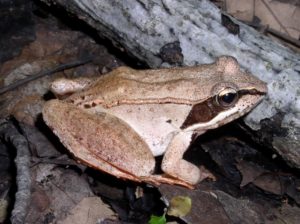
Listen for the “peent” call of the American woodcock. It’s peak duck season through mid-April, but that “quacking” call you hear may be the wood frogs, always in a hurry—calling and mating early—check for egg masses in the vernal pools. The tiny spring peepers produce a deafening spring chorus. Northern water snakes are basking on the tussocks trying to warm up. Ribbon and garter snakes are on the move as are spotted turtles. On a warm day, look for basking painted turtles. The skunk cabbage flower is almost gone by, but take a close look at the red glow on the maples—their tiny red flowers.
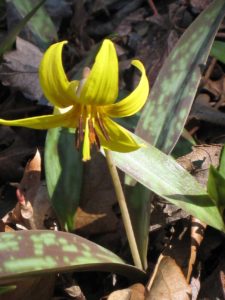 The Eastern phoebe arrives—look for the wagging tail as it calls its name. Ducks are still active—migrating blue-winged teal are late arrivals. Look quickly as the mourning cloak butterflies flit past; they get an early start by overwintering as adults. The tiny blue spring azure is also an early butterfly. Spring ephemerals begin their brief flowering cycle – the bright yellow trout lily is one of the first to bloom.
The Eastern phoebe arrives—look for the wagging tail as it calls its name. Ducks are still active—migrating blue-winged teal are late arrivals. Look quickly as the mourning cloak butterflies flit past; they get an early start by overwintering as adults. The tiny blue spring azure is also an early butterfly. Spring ephemerals begin their brief flowering cycle – the bright yellow trout lily is one of the first to bloom.
April 1- 15
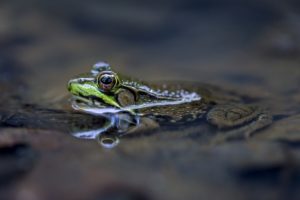
Tree swallows appear, seemingly overnight, gracefully swooping through the air. The early warblers—palm and pine arrive. The small blue-gray gnatcatcher can be seen as well as the great egret slowly stalking on the ponds. Bullfrogs and green frogs join the chorus. In the woods, look for the white clouds of the shadbush’s early bloom, before the other trees have leafed out.
April 16 -30
The songbird migration is picking up: look for Eastern kingbird, or an early black and white warbler. The mallard is already on her nest. More flowers rush to bloom taking advantage of the intensity of spring sun before trees leaf out, creating shade: carpets of the pink-striped spring beauty, star flower, dwarf ginsing, wood anemone.
May 1–15
 It’s the peak of spring songbird migration—the woods are full of color and sound. Listen for the haunting call of the thrushes. Vireos and brilliantly-colored migrating warblers abound. The tiny ruby-throated hummingbird buzzes past. Spring ephemerals are giving way to showy summer flowers: golden ragwort, the spectacular pinxter azalea, the blue flag iris, the floating yellow spatterdock. All too soon, summer arrives.
It’s the peak of spring songbird migration—the woods are full of color and sound. Listen for the haunting call of the thrushes. Vireos and brilliantly-colored migrating warblers abound. The tiny ruby-throated hummingbird buzzes past. Spring ephemerals are giving way to showy summer flowers: golden ragwort, the spectacular pinxter azalea, the blue flag iris, the floating yellow spatterdock. All too soon, summer arrives.
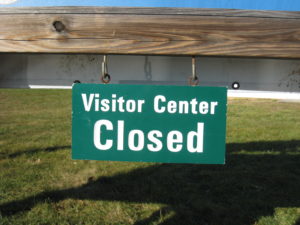
Things just aren’t the same at Great Swamp National Wildlife Refuge today – due to the partial government shutdown. The Refuge staff has been furloughed. They are not being paid, and their work is not being done, creating a month-long backlog – so far!
The Visitor Center is closed although the trails are open. At the Wildlife Observation Center, the most popular visitor destination at the Refuge, the automatic gate has malfunctioned and cannot be repaired until the government shutdown has ended. So visitors have to park in the small area in front of the gate and walk in from there.
The Friends are also being affected negatively by this situation. The Nature Shop, located in the Visitor Center, is closed and Friends have received no income from sales in over a month. Regularly scheduled programs, such as the January Second Sunday program, had to be cancelled. Committee planning meetings have not been held, which affects development of the Calendar of Events, creating new interpretive exhibits, and outreach programs.
Volunteers donate their time and talents to the Refuge because it’s a place we care about. Right now, volunteers are also on leave and their projects are on hold. Plans to renovate the Garden Club Blind have been brought to a stand-still as well as other initiatives.
The Refuge works with a number of other partners and those workshops and programs have also been affected or cancelled due to the continuing shutdown.
The number of people affected by the shutdown at Great Swamp National Wildlife Refuge is unknown, but as you can imagine, there is a ripple effect which touches many people directly or indirectly – whether they are U.S. Fish and Wildlife Service employees, volunteers, visitors, partners, and those who would have participated in events, programs, or workshops.
Contact your Congressional representatives and urge them to end the shutdown so the staff can return to work, volunteers can resume their duties and Congress can get busy with the real issues – the reason we sent them to Washington in the first place.

The White Oak Trail will be getting a butch haircut soon. Refuge staff will be mowing this brushland field as part of their habitat management plan. Bushlands require periodic maintenance to regenerate and support dependent wildlife – like the American Woodcock, a bird that uses brushland during nesting, brood-rearing, and foraging activities.
So, be prepared. The White Oak Trail and surrounding brushlands along Pleasant Plains Road will look very different after mowing. But brushlands regenerate quickly and new vegetation will emerge in less than a year, bringing in many kinds of songbirds.
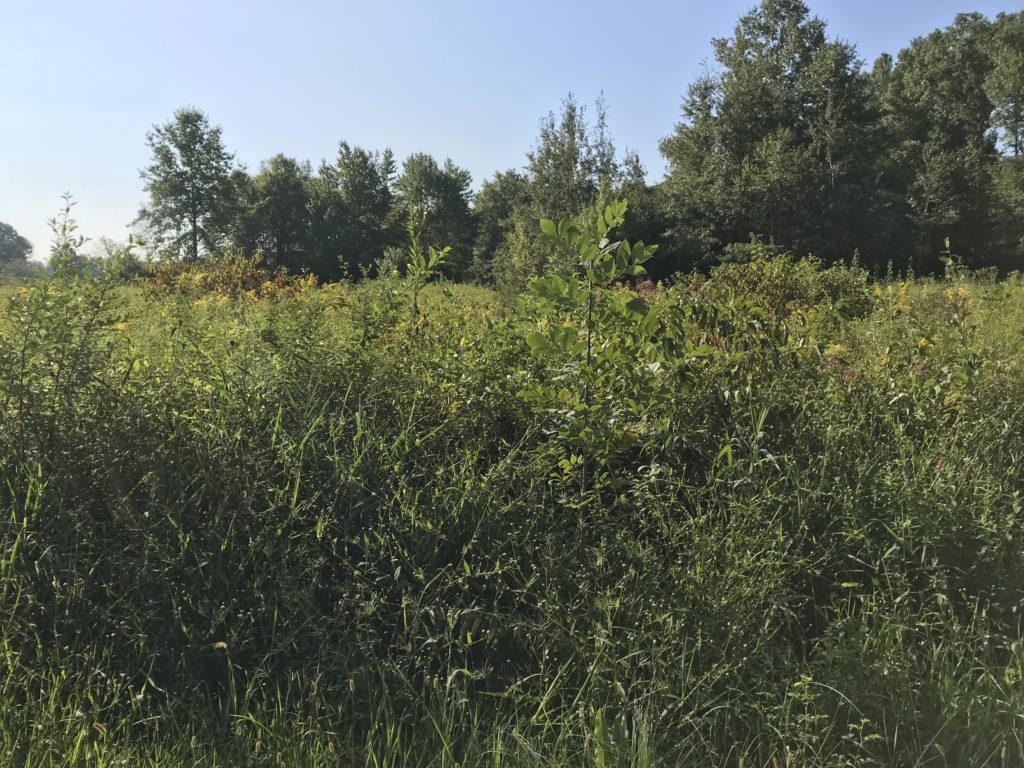
Sure, the White Oak Trail will seem a little bare and open for a while, but this is a great opportunity to track and enjoy emerging vegetation as the field regenerates over the coming year. Active management helps to sustain both brushland and woodcocks – and ensures successful Woodcock Walks each Spring.
Photos: Marilyn Kitchell
Friday, November 30 through Sunday, December 2, 10:00 am to 4:00 pm.
 Start your holiday shopping at the Friends Nature Shop.
Start your holiday shopping at the Friends Nature Shop.
10% discount on all items – 20% discount for members
Not a member? Join any time. Your membership discount is effective immediately.
Check out our unique and original gift items for kids and adults; nature books, puzzles and games; sweatshirts, fleece, denim, hats and more. We will also have DVD copies of Saving the Great Swamp for sale.
Free parking, no lines, hands-on activities for kids in the Discovery Den.
All Nature Shop proceeds are used to fund Refuge projects – so you are also supporting your favorite place – Great Swamp National Wildlife Refuge.


November is Turkey Time!
On Saturday, November 24, join us for the Annual Turkey Walk — a chance to walk off that Thanksgiving turkey dinner. It’s a leisurely walk along service roads, a good birding opportunity, and we might even see a turkey! This is an informal guided walk into the Management Area, normally closed to the public, about 1 ½ miles round trip. Saturday, November 24, 1 – 2:30 p.m. Meet at the Bluebird Parking Lot, 197 Pleasant Plains Road, Harding Township. Please be prompt.
Celebrate Double Discount Days in December!
Holiday shopping, Friday, November 30 – Sunday, December 2, at the Friends Nature Shop located at the Helen C. Fenske Visitor Center. We carry nature books and field guides, nature-themed gift items, jewelry, puzzles, plush, and Judy’s pottery. Enjoy a 10% discount on all purchases and 20% if you are a Friends member. Can you imagine a better place to do your holiday shopping? No lines, free parking, and best of all, proceeds are used to fund Refuge projects and programs. Shop for your family and friends and support Great Swamp National Wildlife Refuge.
Don’t forget Great Swamp National Wildlife Refuge is a great place to visit in the winter. Raptors can be seen hunting over the fields along Pleasant Plains Road. Herons and ducks are still around until the water freezes over. The feeders at the Visitor Center are always busy – a great place to learn your backyard birds and to get started on your Junior Refuge Manager Activity Guide. There are fewer people and no bugs! Enjoy your national wildlife refuge.

